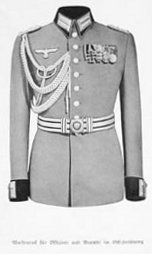Waffenrock on:
[Wikipedia]
[Google]
[Amazon]
 ( lso ) was originally a medieval German term for an outer garment, worn by
( lso ) was originally a medieval German term for an outer garment, worn by
File:1967 CPA 3589.jpg,
File:Raphael - Saint George and the Dragon - Google Art Project.jpg, ) and lance
File:Peraldus Knight.jpg,
File:Codex Manesse (Herzog) von Anhalt.jpg,
Dresden-Zwinger-Armoury-Tournament.01.JPG,
The gallery below shows examples until 1945.
Frederick II of Prussia.jpg,
Stabsfeldwebel k.u.k InfRgt 94.png,
Franz von Berger.jpg,
Zollmuseum HH Waffenrock Hamburger Zollkontrolleur.jpg,
Wehrmacht Heer Waffenrock 3.jpg, {{center, {{lang, de, Waffenrock Hauptmann of the {{lang, de, i=unset, Wehrmacht ca. 1939
 ( lso ) was originally a medieval German term for an outer garment, worn by
( lso ) was originally a medieval German term for an outer garment, worn by knight
A knight is a person granted an honorary title of knighthood by a head of state (including the Pope) or representative for service to the monarch, the Christian denomination, church or the country, especially in a military capacity. Knighthood ...
s over their armor
Armour (British English) or armor (American English; see spelling differences) is a covering used to protect an object, individual, or vehicle from physical injury or damage, especially direct contact weapons or projectiles during combat, or f ...
.
Later, became the generic term for any military uniform
A military uniform is a standardised dress worn by members of the armed forces and paramilitaries of various nations.
Military dress and styles have gone through significant changes over the centuries, from colourful and elaborate, ornamented ...
, including dress and parade uniforms, and also referred to epaulettes
Epaulette (; also spelled epaulet) is a type of ornamental shoulder piece or decoration used as insignia of rank by armed forces and other organizations. Flexible metal epaulettes (usually made from brass) are referred to as ''shoulder scales'' ...
or shoulder boards with rank insignia, as well as uniform cuffs, badges and other insignia. As of 1945, the term is no longer in use by German speaking armed forces, though the Swedish term for a military tunic is the cognate .
Historical roots
was derived from the substantive ''wâfenroc'' or ''wâpenroc'' ("weapon tunic") of knights. It was often made from expensive silk cloth. The colours of this cloth corresponded to those on the shield quartering. In spirit of this, the heraldic figures on the coat of arms were frequently designed by gold and silver embroidery. In the Prussian Army, the service coat was common called . It was renamed to ("soldier's tunic") in October 23, 1842, by the Prussian cabinet order of His Majesty (german: allerhöchste Kabinettsorder). In 1843, it was finally renamed to .Word and tradition in the German Army (de: Heer), by Transfeldt – v. Brand – Quenstedt, 6th increased edition, Hamburg 11 H.G. Schulz 1967, p. 2, roots of the noun: . All German-speaking armies commonly used this wording, except for theAustro-Hungarian Army
The Austro-Hungarian Army (, literally "Ground Forces of the Austro-Hungarians"; , literally "Imperial and Royal Army") was the ground force of the Austro-Hungarian Dual Monarchy from 1867 to 1918. It was composed of three parts: the joint arm ...
(later Austrian Army
The Austrian Armed Forces (german: Bundesheer, lit=Federal Army) are the combined military forces of the Republic of Austria.
The military consists of 22,050 active-duty personnel and 125,600 reservists. The military budget is 0.74% of nat ...
), where the designation was in use.
World War II use
In its form as issued in 1935, it was a formfitting thigh-length eight-button tunic of fine wool, without external pockets. The collar was taller than the service tunic and bore more elaborate embroidered all in silver-white and mounted on backing; smaller , similar in appearance to , appeared under the buttons on the dark-green Swedish cuffs. piping also edged the collar, cuffs, front closure, and scalloped rear vent. Officers wore a formal belt of silver braid. Trousers were , with the outer seams piped in . In the full-dress uniform () the was worn with medals, aiguillette (officers), trousers and shoes, the , gloves, and sword (officers/senior NCOs) or dress bayonet (enlisted). Parade dress substituted the steel helmet and jackboots. Semi-formal () and walking-out () uniforms were as full-dress, but without aiguillette and with ribbons replacing medals. Production and issue of the was suspended in 1940, and either the service or the officers' ornamented uniform was worn for dress occasions instead. However, the remained authorized for walking out for those who had or could purchase it; and it was a widespread if unauthorized practice to loan a soldier a from regimental stocks to get married in, as evidenced by many wartime wedding photos.Historical examples
The gallery below shows examples of over the suit of armor.See also
*Adjustierung
''Adjustierung'' (literal: ''adjustation'' | AT: ienstkleidung en: service dress) is derived from the German (Austrian) verb ''adjustieren'' (AT: usrüsten en: equipLangenscheidt´s Encyclopaedic Dictionary of the English and German langu ...
* Tunic (military)
References